Effective communication skills for managers What is Communication?

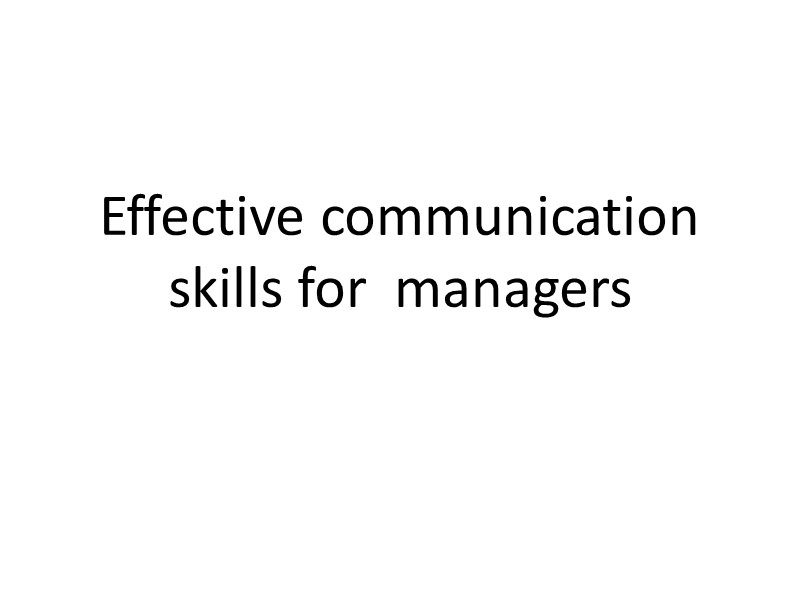
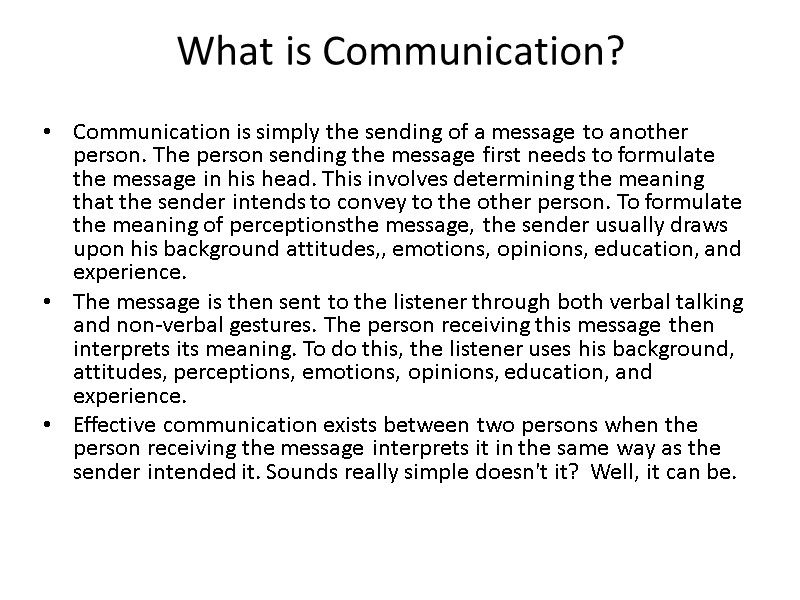
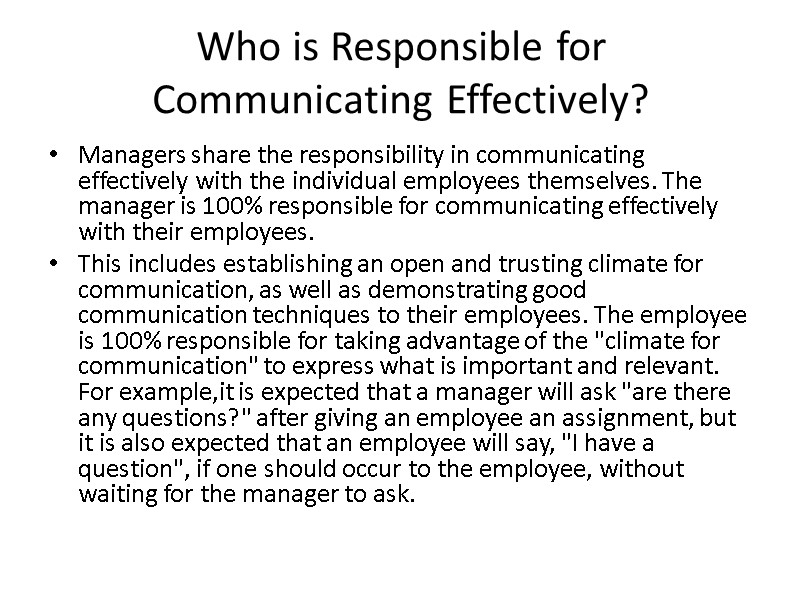
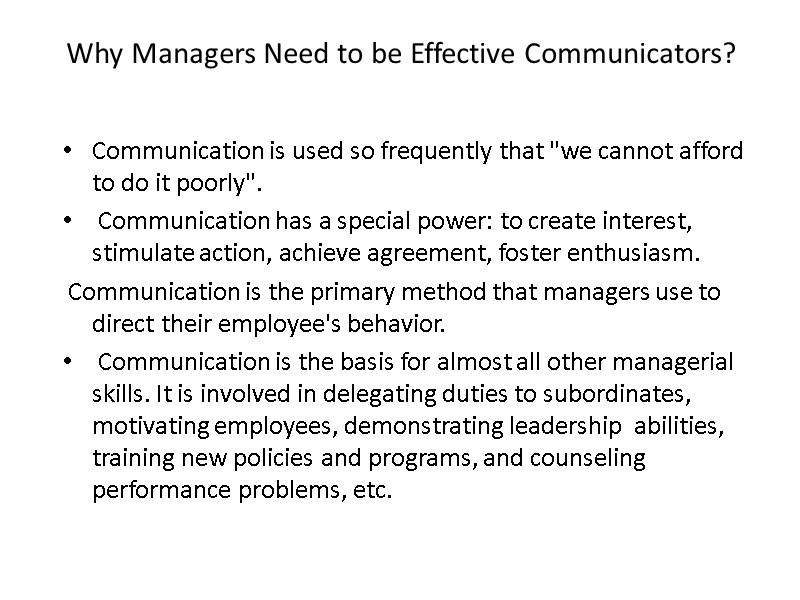
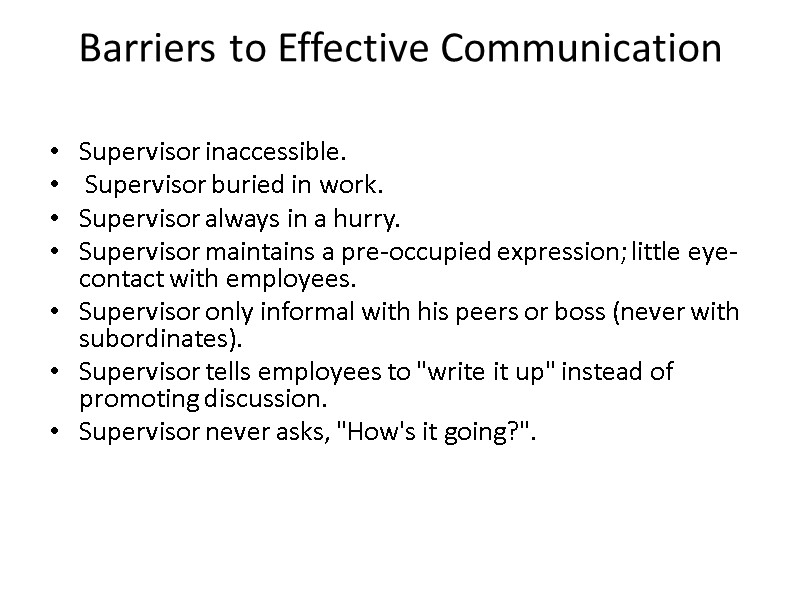
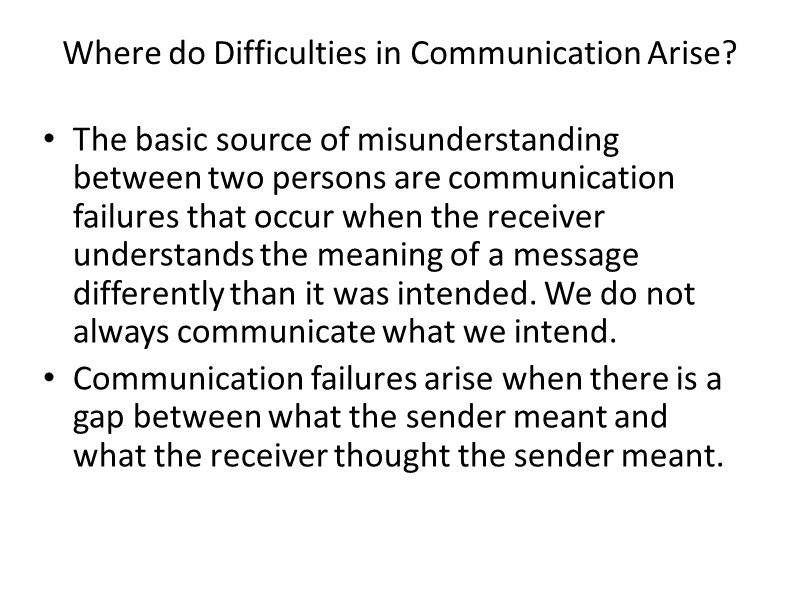
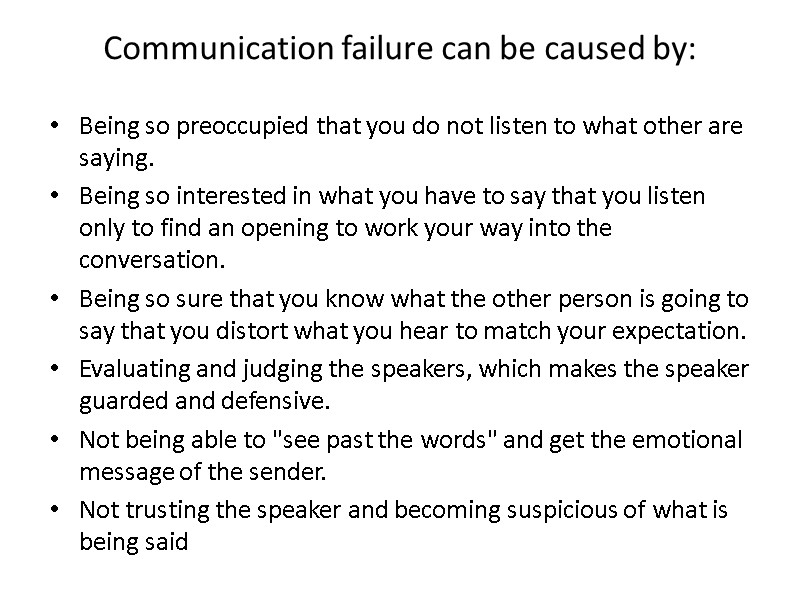
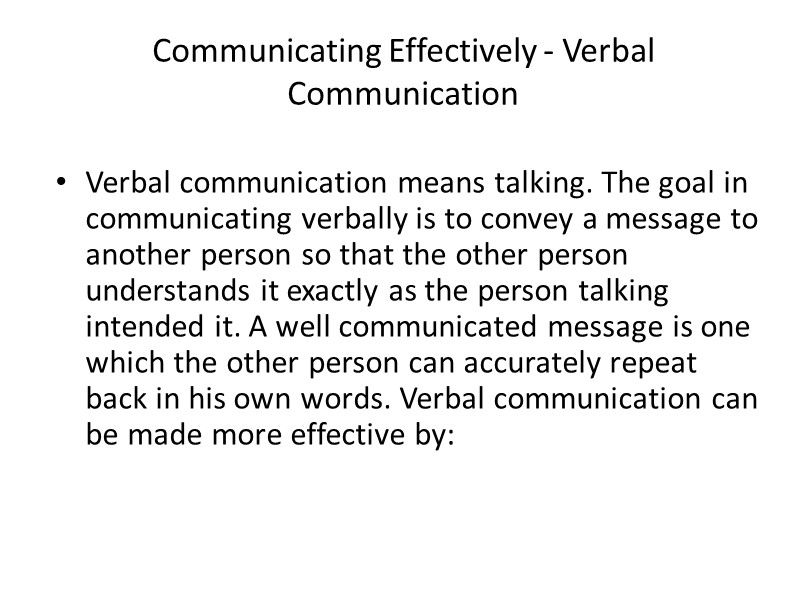
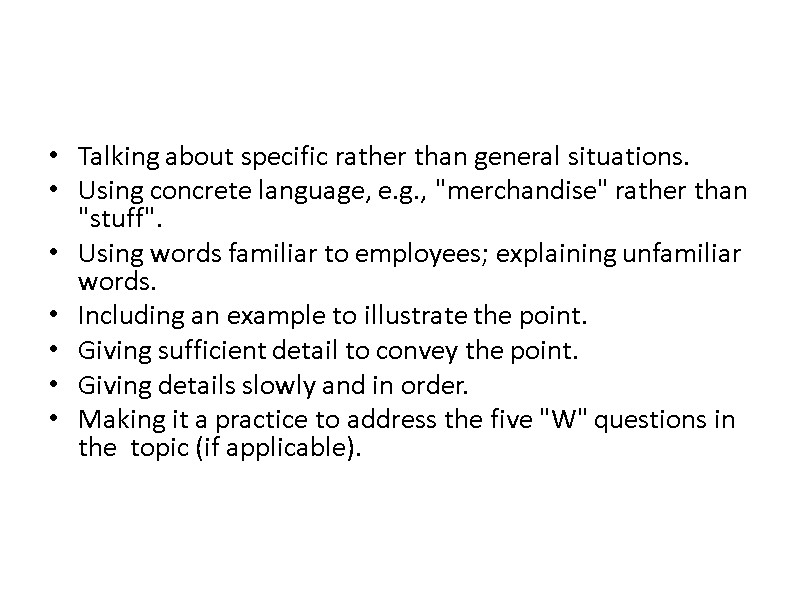
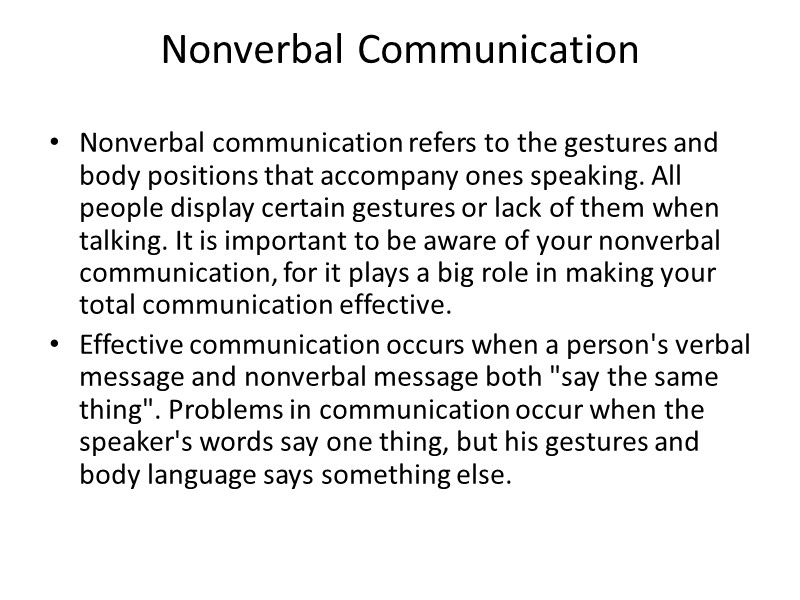
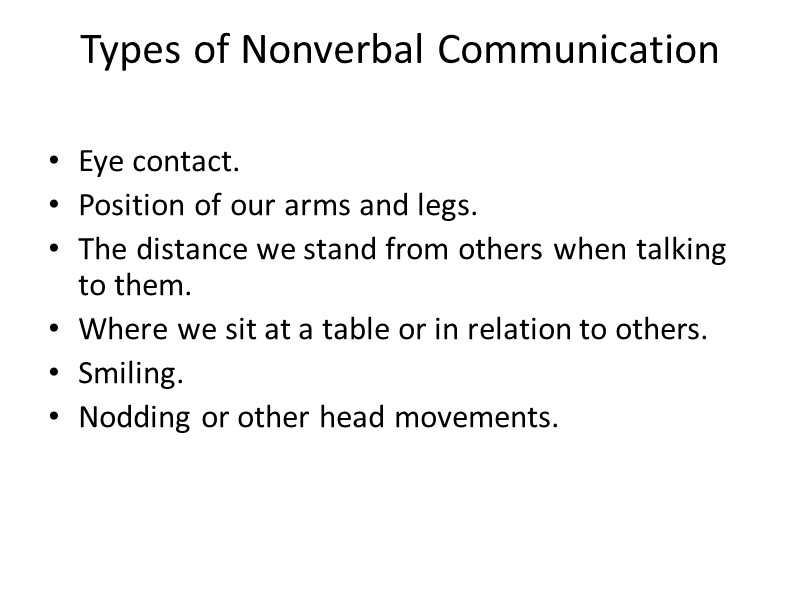
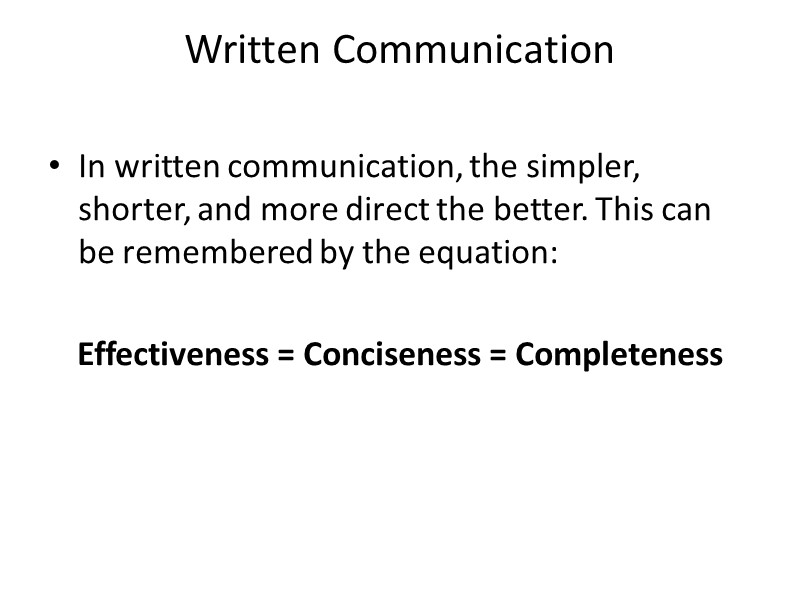
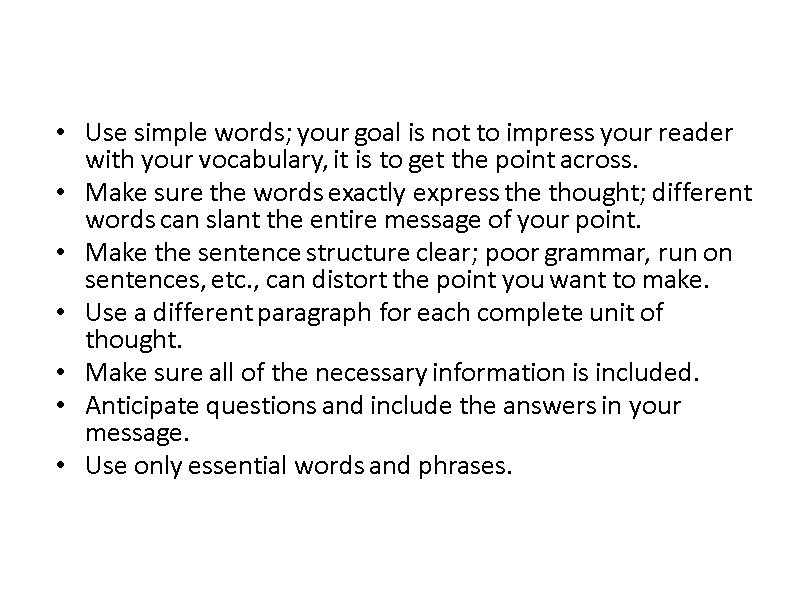
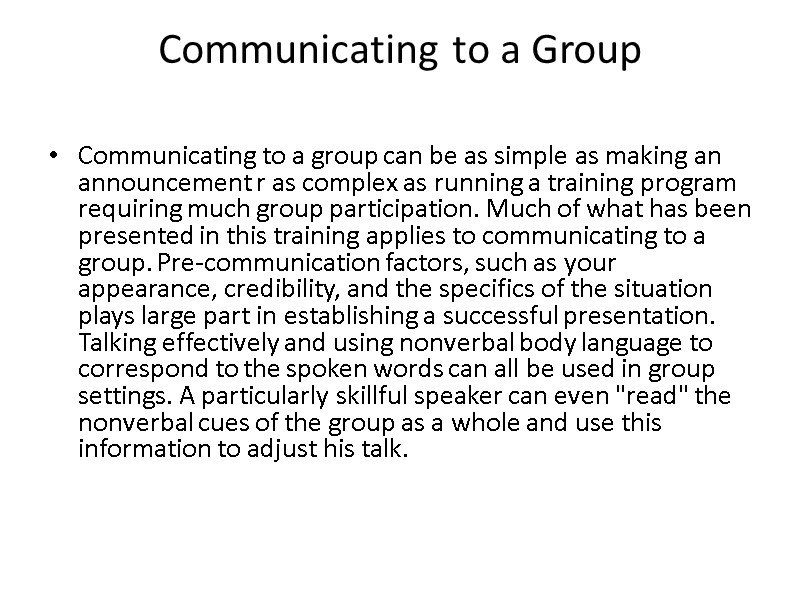
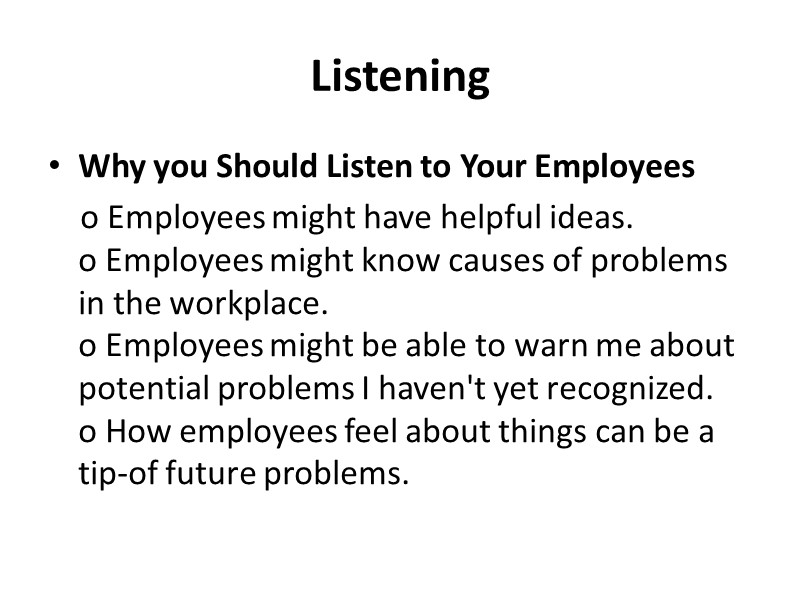
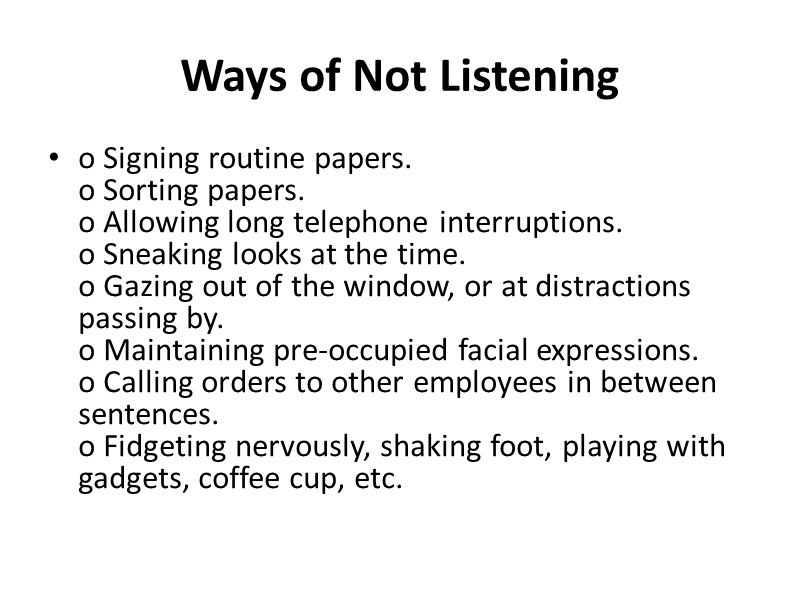
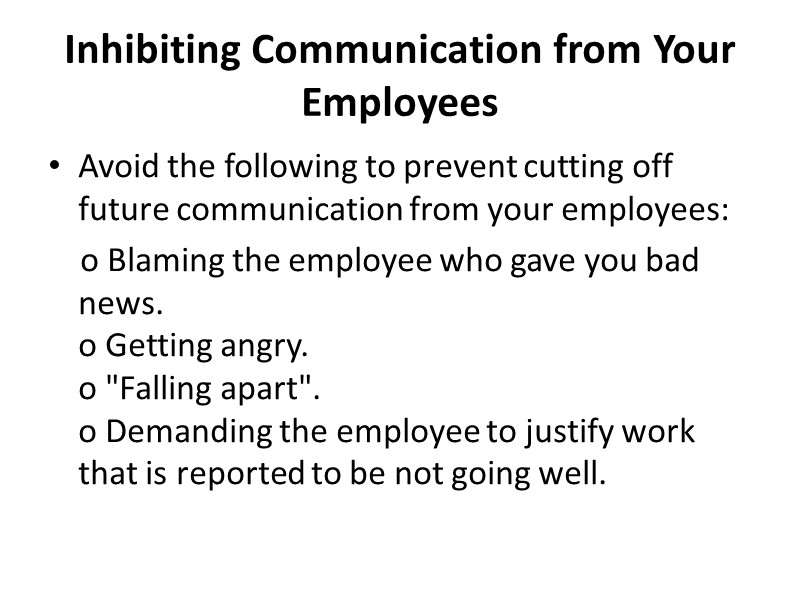
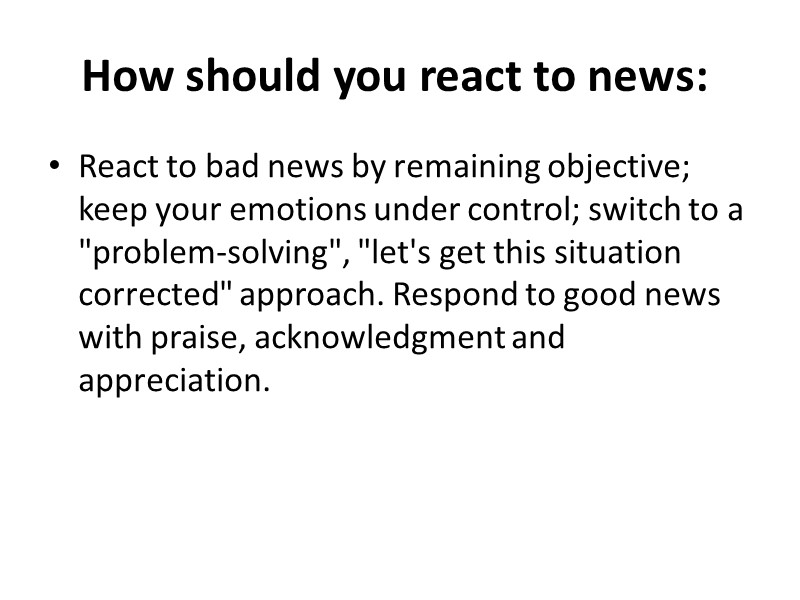
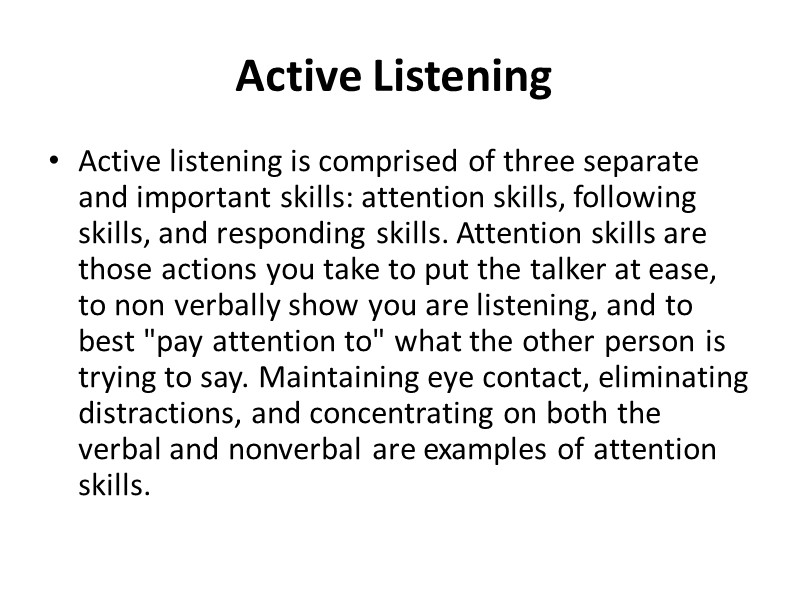
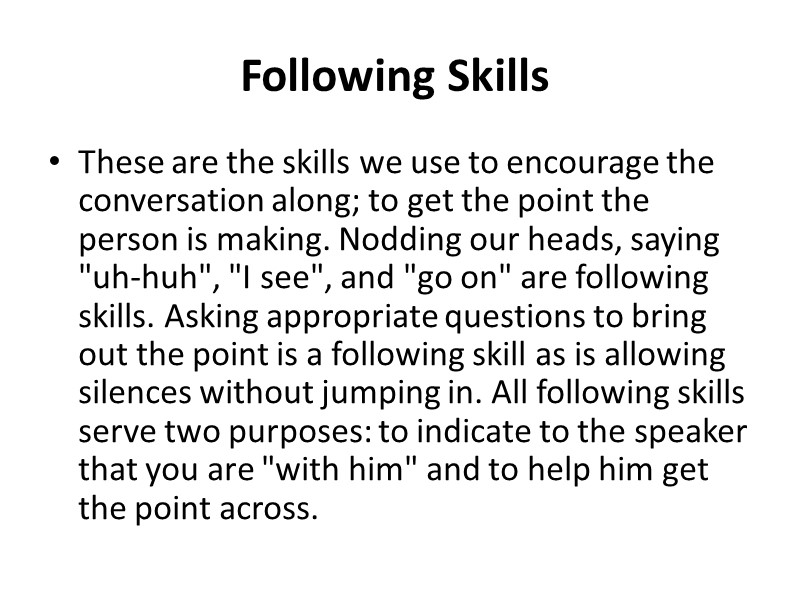
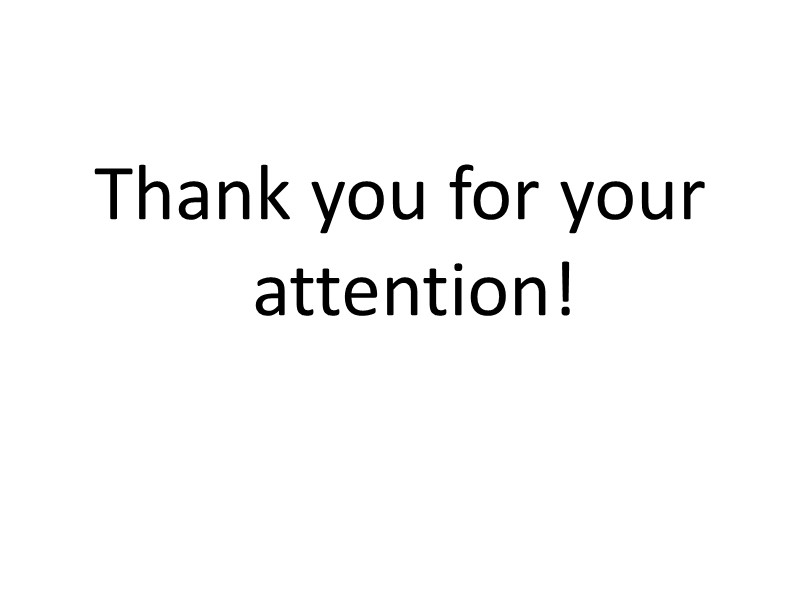
40654-effective_communication_skills_for_managers.ppt
- Количество слайдов: 21
 Effective communication skills for managers
Effective communication skills for managers
 What is Communication? Communication is simply the sending of a message to another person. The person sending the message first needs to formulate the message in his head. This involves determining the meaning that the sender intends to convey to the other person. To formulate the meaning of perceptionsthe message, the sender usually draws upon his background attitudes,, emotions, opinions, education, and experience. The message is then sent to the listener through both verbal talking and non-verbal gestures. The person receiving this message then interprets its meaning. To do this, the listener uses his background, attitudes, perceptions, emotions, opinions, education, and experience. Effective communication exists between two persons when the person receiving the message interprets it in the same way as the sender intended it. Sounds really simple doesn't it? Well, it can be.
What is Communication? Communication is simply the sending of a message to another person. The person sending the message first needs to formulate the message in his head. This involves determining the meaning that the sender intends to convey to the other person. To formulate the meaning of perceptionsthe message, the sender usually draws upon his background attitudes,, emotions, opinions, education, and experience. The message is then sent to the listener through both verbal talking and non-verbal gestures. The person receiving this message then interprets its meaning. To do this, the listener uses his background, attitudes, perceptions, emotions, opinions, education, and experience. Effective communication exists between two persons when the person receiving the message interprets it in the same way as the sender intended it. Sounds really simple doesn't it? Well, it can be.
 Who is Responsible for Communicating Effectively? Managers share the responsibility in communicating effectively with the individual employees themselves. The manager is 100% responsible for communicating effectively with their employees. This includes establishing an open and trusting climate for communication, as well as demonstrating good communication techniques to their employees. The employee is 100% responsible for taking advantage of the "climate for communication" to express what is important and relevant. For example,it is expected that a manager will ask "are there any questions?" after giving an employee an assignment, but it is also expected that an employee will say, "I have a question", if one should occur to the employee, without waiting for the manager to ask.
Who is Responsible for Communicating Effectively? Managers share the responsibility in communicating effectively with the individual employees themselves. The manager is 100% responsible for communicating effectively with their employees. This includes establishing an open and trusting climate for communication, as well as demonstrating good communication techniques to their employees. The employee is 100% responsible for taking advantage of the "climate for communication" to express what is important and relevant. For example,it is expected that a manager will ask "are there any questions?" after giving an employee an assignment, but it is also expected that an employee will say, "I have a question", if one should occur to the employee, without waiting for the manager to ask.
 Why Managers Need to be Effective Communicators? Communication is used so frequently that "we cannot afford to do it poorly". Communication has a special power: to create interest, stimulate action, achieve agreement, foster enthusiasm. Communication is the primary method that managers use to direct their employee's behavior. Communication is the basis for almost all other managerial skills. It is involved in delegating duties to subordinates, motivating employees, demonstrating leadership abilities, training new policies and programs, and counseling performance problems, etc.
Why Managers Need to be Effective Communicators? Communication is used so frequently that "we cannot afford to do it poorly". Communication has a special power: to create interest, stimulate action, achieve agreement, foster enthusiasm. Communication is the primary method that managers use to direct their employee's behavior. Communication is the basis for almost all other managerial skills. It is involved in delegating duties to subordinates, motivating employees, demonstrating leadership abilities, training new policies and programs, and counseling performance problems, etc.
 Barriers to Effective Communication Supervisor inaccessible. Supervisor buried in work. Supervisor always in a hurry. Supervisor maintains a pre-occupied expression; little eye-contact with employees. Supervisor only informal with his peers or boss (never with subordinates). Supervisor tells employees to "write it up" instead of promoting discussion. Supervisor never asks, "How's it going?".
Barriers to Effective Communication Supervisor inaccessible. Supervisor buried in work. Supervisor always in a hurry. Supervisor maintains a pre-occupied expression; little eye-contact with employees. Supervisor only informal with his peers or boss (never with subordinates). Supervisor tells employees to "write it up" instead of promoting discussion. Supervisor never asks, "How's it going?".
 Where do Difficulties in Communication Arise? The basic source of misunderstanding between two persons are communication failures that occur when the receiver understands the meaning of a message differently than it was intended. We do not always communicate what we intend. Communication failures arise when there is a gap between what the sender meant and what the receiver thought the sender meant.
Where do Difficulties in Communication Arise? The basic source of misunderstanding between two persons are communication failures that occur when the receiver understands the meaning of a message differently than it was intended. We do not always communicate what we intend. Communication failures arise when there is a gap between what the sender meant and what the receiver thought the sender meant.
 Communication failure can be caused by: Being so preoccupied that you do not listen to what other are saying. Being so interested in what you have to say that you listen only to find an opening to work your way into the conversation. Being so sure that you know what the other person is going to say that you distort what you hear to match your expectation. Evaluating and judging the speakers, which makes the speaker guarded and defensive. Not being able to "see past the words" and get the emotional message of the sender. Not trusting the speaker and becoming suspicious of what is being said
Communication failure can be caused by: Being so preoccupied that you do not listen to what other are saying. Being so interested in what you have to say that you listen only to find an opening to work your way into the conversation. Being so sure that you know what the other person is going to say that you distort what you hear to match your expectation. Evaluating and judging the speakers, which makes the speaker guarded and defensive. Not being able to "see past the words" and get the emotional message of the sender. Not trusting the speaker and becoming suspicious of what is being said
 Communicating Effectively - Verbal Communication Verbal communication means talking. The goal in communicating verbally is to convey a message to another person so that the other person understands it exactly as the person talking intended it. A well communicated message is one which the other person can accurately repeat back in his own words. Verbal communication can be made more effective by:
Communicating Effectively - Verbal Communication Verbal communication means talking. The goal in communicating verbally is to convey a message to another person so that the other person understands it exactly as the person talking intended it. A well communicated message is one which the other person can accurately repeat back in his own words. Verbal communication can be made more effective by:
 Talking about specific rather than general situations. Using concrete language, e.g., "merchandise" rather than "stuff". Using words familiar to employees; explaining unfamiliar words. Including an example to illustrate the point. Giving sufficient detail to convey the point. Giving details slowly and in order. Making it a practice to address the five "W" questions in the topic (if applicable).
Talking about specific rather than general situations. Using concrete language, e.g., "merchandise" rather than "stuff". Using words familiar to employees; explaining unfamiliar words. Including an example to illustrate the point. Giving sufficient detail to convey the point. Giving details slowly and in order. Making it a practice to address the five "W" questions in the topic (if applicable).
 Nonverbal Communication Nonverbal communication refers to the gestures and body positions that accompany ones speaking. All people display certain gestures or lack of them when talking. It is important to be aware of your nonverbal communication, for it plays a big role in making your total communication effective. Effective communication occurs when a person's verbal message and nonverbal message both "say the same thing". Problems in communication occur when the speaker's words say one thing, but his gestures and body language says something else.
Nonverbal Communication Nonverbal communication refers to the gestures and body positions that accompany ones speaking. All people display certain gestures or lack of them when talking. It is important to be aware of your nonverbal communication, for it plays a big role in making your total communication effective. Effective communication occurs when a person's verbal message and nonverbal message both "say the same thing". Problems in communication occur when the speaker's words say one thing, but his gestures and body language says something else.
 Types of Nonverbal Communication Eye contact. Position of our arms and legs. The distance we stand from others when talking to them. Where we sit at a table or in relation to others. Smiling. Nodding or other head movements.
Types of Nonverbal Communication Eye contact. Position of our arms and legs. The distance we stand from others when talking to them. Where we sit at a table or in relation to others. Smiling. Nodding or other head movements.
 Written Communication In written communication, the simpler, shorter, and more direct the better. This can be remembered by the equation: Effectiveness = Conciseness = Completeness
Written Communication In written communication, the simpler, shorter, and more direct the better. This can be remembered by the equation: Effectiveness = Conciseness = Completeness
 Use simple words; your goal is not to impress your reader with your vocabulary, it is to get the point across. Make sure the words exactly express the thought; different words can slant the entire message of your point. Make the sentence structure clear; poor grammar, run on sentences, etc., can distort the point you want to make. Use a different paragraph for each complete unit of thought. Make sure all of the necessary information is included. Anticipate questions and include the answers in your message. Use only essential words and phrases.
Use simple words; your goal is not to impress your reader with your vocabulary, it is to get the point across. Make sure the words exactly express the thought; different words can slant the entire message of your point. Make the sentence structure clear; poor grammar, run on sentences, etc., can distort the point you want to make. Use a different paragraph for each complete unit of thought. Make sure all of the necessary information is included. Anticipate questions and include the answers in your message. Use only essential words and phrases.
 Communicating to a Group Communicating to a group can be as simple as making an announcement r as complex as running a training program requiring much group participation. Much of what has been presented in this training applies to communicating to a group. Pre-communication factors, such as your appearance, credibility, and the specifics of the situation plays large part in establishing a successful presentation. Talking effectively and using nonverbal body language to correspond to the spoken words can all be used in group settings. A particularly skillful speaker can even "read" the nonverbal cues of the group as a whole and use this information to adjust his talk.
Communicating to a Group Communicating to a group can be as simple as making an announcement r as complex as running a training program requiring much group participation. Much of what has been presented in this training applies to communicating to a group. Pre-communication factors, such as your appearance, credibility, and the specifics of the situation plays large part in establishing a successful presentation. Talking effectively and using nonverbal body language to correspond to the spoken words can all be used in group settings. A particularly skillful speaker can even "read" the nonverbal cues of the group as a whole and use this information to adjust his talk.
 Listening Why you Should Listen to Your Employees o Employees might have helpful ideas. o Employees might know causes of problems in the workplace. o Employees might be able to warn me about potential problems I haven't yet recognized. o How employees feel about things can be a tip-of future problems.
Listening Why you Should Listen to Your Employees o Employees might have helpful ideas. o Employees might know causes of problems in the workplace. o Employees might be able to warn me about potential problems I haven't yet recognized. o How employees feel about things can be a tip-of future problems.
 Ways of Not Listening o Signing routine papers. o Sorting papers. o Allowing long telephone interruptions. o Sneaking looks at the time. o Gazing out of the window, or at distractions passing by. o Maintaining pre-occupied facial expressions. o Calling orders to other employees in between sentences. o Fidgeting nervously, shaking foot, playing with gadgets, coffee cup, etc.
Ways of Not Listening o Signing routine papers. o Sorting papers. o Allowing long telephone interruptions. o Sneaking looks at the time. o Gazing out of the window, or at distractions passing by. o Maintaining pre-occupied facial expressions. o Calling orders to other employees in between sentences. o Fidgeting nervously, shaking foot, playing with gadgets, coffee cup, etc.
 Inhibiting Communication from Your Employees Avoid the following to prevent cutting off future communication from your employees: o Blaming the employee who gave you bad news. o Getting angry. o "Falling apart". o Demanding the employee to justify work that is reported to be not going well.
Inhibiting Communication from Your Employees Avoid the following to prevent cutting off future communication from your employees: o Blaming the employee who gave you bad news. o Getting angry. o "Falling apart". o Demanding the employee to justify work that is reported to be not going well.
 How should you react to news: React to bad news by remaining objective; keep your emotions under control; switch to a "problem-solving", "let's get this situation corrected" approach. Respond to good news with praise, acknowledgment and appreciation.
How should you react to news: React to bad news by remaining objective; keep your emotions under control; switch to a "problem-solving", "let's get this situation corrected" approach. Respond to good news with praise, acknowledgment and appreciation.
 Active Listening Active listening is comprised of three separate and important skills: attention skills, following skills, and responding skills. Attention skills are those actions you take to put the talker at ease, to non verbally show you are listening, and to best "pay attention to" what the other person is trying to say. Maintaining eye contact, eliminating distractions, and concentrating on both the verbal and nonverbal are examples of attention skills.
Active Listening Active listening is comprised of three separate and important skills: attention skills, following skills, and responding skills. Attention skills are those actions you take to put the talker at ease, to non verbally show you are listening, and to best "pay attention to" what the other person is trying to say. Maintaining eye contact, eliminating distractions, and concentrating on both the verbal and nonverbal are examples of attention skills.
 Following Skills These are the skills we use to encourage the conversation along; to get the point the person is making. Nodding our heads, saying "uh-huh", "I see", and "go on" are following skills. Asking appropriate questions to bring out the point is a following skill as is allowing silences without jumping in. All following skills serve two purposes: to indicate to the speaker that you are "with him" and to help him get the point across.
Following Skills These are the skills we use to encourage the conversation along; to get the point the person is making. Nodding our heads, saying "uh-huh", "I see", and "go on" are following skills. Asking appropriate questions to bring out the point is a following skill as is allowing silences without jumping in. All following skills serve two purposes: to indicate to the speaker that you are "with him" and to help him get the point across.
 Thank you for your attention!
Thank you for your attention!

